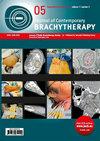Adjuvant pulse-dose-rate brachytherapy for oral cavity and oropharynx carcinoma: Outcome and toxicity assessment of 66 patients
IF 1.1
4区 医学
Q4 ONCOLOGY
引用次数: 0
Abstract
Purpose:Brachytherapy (BT) is a validated radiation technique for treatment of early stage tumors of oral cavity and oropharynx. This study aimed to analyze the results of our institute’s patients after replacing low-dose-rate (LDR) with pulse-dose-rate (PDR) brachytherapy.
Material and methods:
We retrospectively collected data from all patients treated between 2009 and 2020 for squamous cell carcinoma (floor of the mouth, tongue, and oropharynx) using adjuvant interstitial BT with or without external RT. Primary outcome was local control. Secondary outcomes were regional control rate and toxicity. Statistical analysis of local and regional recurrences were described using Kaplan-Meier method. Prognostic value of each factor for recurrence or toxicity was evaluated with bivariate Fine-Gray model.
Results:
Data from 66 patients were analyzed. Local and regional recurrences were reported in 11% and 20% of the patients, respectively. No significant factors were identified in the present study. Grade 2 and 3 acute mucositis were reported in 21% of patients, and were more frequent in the BT only group. Almost half (47%) of the patients described acute pain following BT, and 26% required stage 2 or 3 analgesics. Trophic disorders were observed in 16 patients. Five patients presented with soft tissue necrosis (STN) and required medical treatment, of whom one subsequently required hyperbaric oxygen therapy. No predictive factors were identified for STN risk. Two patients developed osteoradionecrosis.
Conclusions:
Oral and oropharyngeal PDR-BT as adjuvant treatment is safe and effective for well-defined indications.
辅助脉冲剂量率近距离放射治疗口腔癌和口咽癌:66 例患者的疗效和毒性评估
目的:近距离放射治疗(BT)是治疗口腔和口咽部早期肿瘤的有效放射技术。材料与方法:我们回顾性地收集了2009年至2020年间所有接受辅助性间质近距离放射治疗的鳞状细胞癌(口底、舌和口咽)患者的数据。主要结果是局部控制率。次要结果是区域控制率和毒性。局部和区域复发的统计分析采用 Kaplan-Meier 法。用Fine-Gray双变量模型评估了各因素对复发或毒性的预后价值。据报道,分别有11%和20%的患者出现局部和区域性复发。本研究未发现任何重要因素。21%的患者出现了2级和3级急性粘膜炎,在仅使用BT的组别中更为常见。近一半(47%)的患者描述了 BT 后的急性疼痛,26% 的患者需要使用 2 级或 3 级镇痛药。16 名患者出现了营养障碍。五名患者出现软组织坏死(STN),需要接受药物治疗,其中一人随后需要接受高压氧治疗。没有发现 STN 风险的预测因素。结论:口腔和口咽PDR-BT作为辅助治疗手段,在明确的适应症中是安全有效的。
本文章由计算机程序翻译,如有差异,请以英文原文为准。
求助全文
约1分钟内获得全文
求助全文
来源期刊

Journal of Contemporary Brachytherapy
ONCOLOGY-RADIOLOGY, NUCLEAR MEDICINE & MEDICAL IMAGING
CiteScore
2.40
自引率
14.30%
发文量
54
审稿时长
16 weeks
期刊介绍:
The “Journal of Contemporary Brachytherapy” is an international and multidisciplinary journal that will publish papers of original research as well as reviews of articles. Main subjects of the journal include: clinical brachytherapy, combined modality treatment, advances in radiobiology, hyperthermia and tumour biology, as well as physical aspects relevant to brachytherapy, particularly in the field of imaging, dosimetry and radiation therapy planning. Original contributions will include experimental studies of combined modality treatment, tumor sensitization and normal tissue protection, molecular radiation biology, and clinical investigations of cancer treatment in brachytherapy. Another field of interest will be the educational part of the journal.
 求助内容:
求助内容: 应助结果提醒方式:
应助结果提醒方式:


